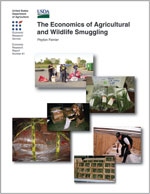The Economics of Agricultural and Wildlife Smuggling
by
Peyton FerrierEconomic Research Report No. (ERR-81) 35 pp, September 2009
 The United States bans imports of certain agricultural and wildlife goods that can carry pathogens or diseases or whose harvest can threaten wildlife stocks or endanger species. Despite these bans, contraband is regularly uncovered in inspections of cargo containers and in domestic markets. This study characterizes the economic factors affecting agricultural and wildlife smuggling by drawing on inspection and interdiction data from USDA and the U.S. Fish and Wildlife Service and existing economic literature. Findings reveal that agricultural and wildlife smuggling primarily include luxury goods, ethnic foods, and specialty goods, such as traditional medicines. Incidents of detected smuggling are disproportionately higher for agricultural goods originating in China and for wildlife goods originating in Mexico. Fragmentary data show that approximately 1 percent of all commercial wildlife shipments to the United States and 0.40 percent of all U.S. wildlife imports by value are refused entry and suspected of being smuggled.
The United States bans imports of certain agricultural and wildlife goods that can carry pathogens or diseases or whose harvest can threaten wildlife stocks or endanger species. Despite these bans, contraband is regularly uncovered in inspections of cargo containers and in domestic markets. This study characterizes the economic factors affecting agricultural and wildlife smuggling by drawing on inspection and interdiction data from USDA and the U.S. Fish and Wildlife Service and existing economic literature. Findings reveal that agricultural and wildlife smuggling primarily include luxury goods, ethnic foods, and specialty goods, such as traditional medicines. Incidents of detected smuggling are disproportionately higher for agricultural goods originating in China and for wildlife goods originating in Mexico. Fragmentary data show that approximately 1 percent of all commercial wildlife shipments to the United States and 0.40 percent of all U.S. wildlife imports by value are refused entry and suspected of being smuggled.
Keywords: Smuggling, illicit trade, SPS, quarantine, endangered species, CITES
In this publication...
Charts and graphs (in .png format) from this report are available in the .zip file listed below. The .zip file also contains a document (readme.txt) that lists the name and title of each chart or graph file.
Need help with PDFs?